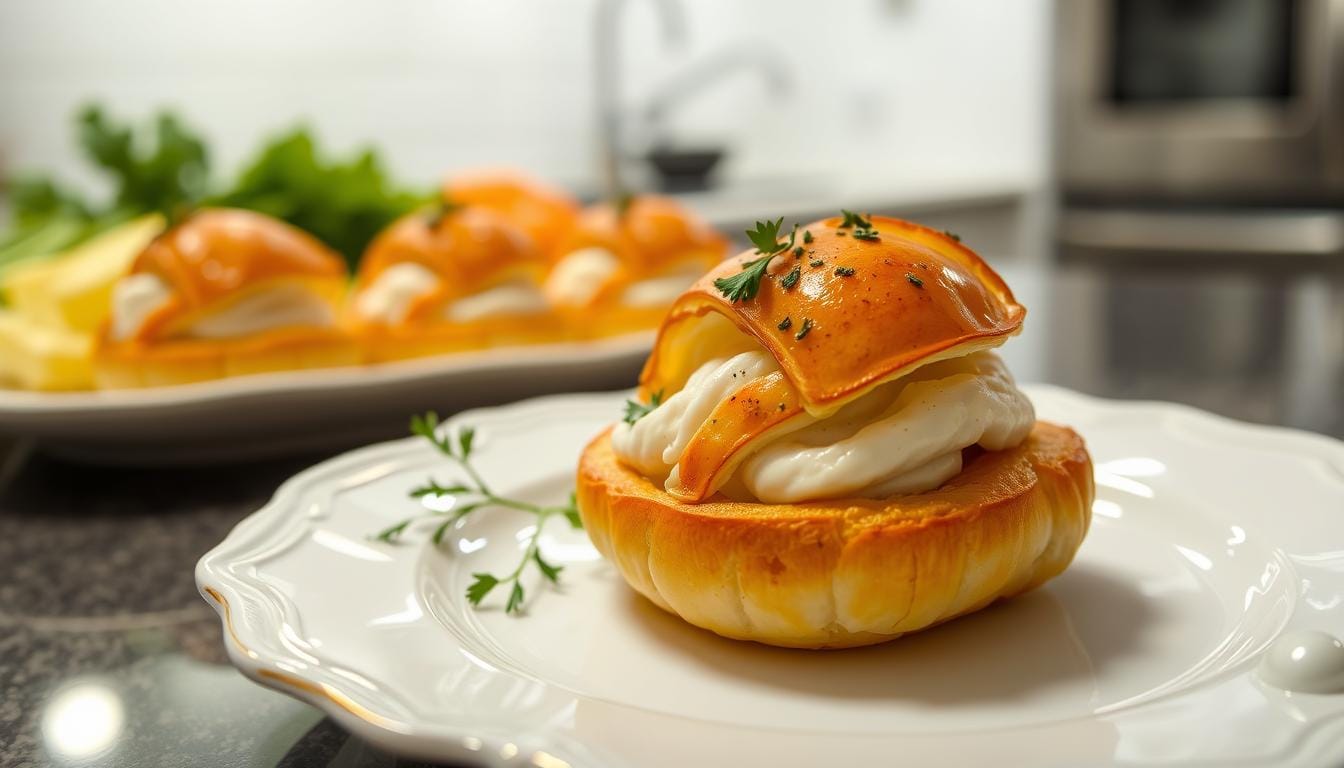Imagine a treat that mixes buttery pastry with tender lobster. It’s a lobster tail pastry, a treat that will satisfy your taste buds. You’re about to dive into the world of lobster tail pastry, learning about its origins, ingredients, and variations.
In this article, you’ll uncover the secrets of lobster tail pastry. You’ll learn about its key ingredients like flour, sugar, and water. You’ll also find out the best baking temperatures and times. It’s perfect for anyone who loves food or wants to try a new dessert.
Introduction to Lobster Tail Pastry
You’ll learn how to make a lobster tail pastry. It starts with baking at 450°F and then at 350°F. You’ll also find out how to get the dough just right, about 1/16 inch thick.
With this knowledge, you can make your own lobster tail pastry at home. Enjoy its delicious taste.
Key Takeaways
- You can make a delicious lobster tail pastry at home with the right ingredients and baking temperatures.
- The key to a perfect lobster tail pastry is in its ingredients, such as all-purpose flour, sugar, and water, and its baking temperatures and durations.
- Lobster tail pastry is a unique and delicious dessert that is sure to satisfy your cravings.
- You can achieve the perfect thickness for rolled dough by using a pasta machine at setting #6.
- The recommended resting time for the dough in the refrigerator is at least 4 hours or overnight, making it a delicious delight.
- Lobster tail pastry is a delicious delight that can be enjoyed by anyone, and it’s perfect for special occasions or as a treat.
What is Lobster Tail Pastry?
Lobster tail pastry is a tasty Italian dessert. It’s a twist on the traditional sfogliatelle, which started in the 17th century. The dough is stretched and rolled into a shell shape. It’s filled with creamy stuff like whipped cream or ricotta.
The origins of lobster tail pastry come from Italian traditions. Its ingredients make it special. You’ll find bread flour, lard, semolina, and ricotta cheese in it.
To make lobster tail pastry, you mix the ingredients just right. Then, you roll out the dough and fill it. This pastry shows the skill and creativity of Italian bakers over the years.
Key Characteristics of Lobster Tail Pastry
- Shell-shaped crust
- Rich and creamy filling
- Italian origins
- Unique ingredients, such as semolina and ricotta cheese
Knowing about the origins and ingredients of lobster tail pastry is rewarding. It lets you see the tradition and skill in making this dessert. Whether you’re an experienced baker or new, trying to make lobster tail pastry is a great way to enjoy Italian flavors and traditions.
How to Make Lobster Tail Pastry at Home
Making lobster tail pastry at home is fun and rewarding. You need just a few ingredients and basic kitchen tools. To begin, mix 4 cups of bread flour, 7 ounces of water, 1 tablespoon of honey, and 1 teaspoon of salt to make the dough.
Step-by-Step Recipe
The recipe for lobster tail pastry has several steps. First, mix the flour, water, honey, and salt to create the dough. Then, knead the dough for about 10 minutes until it’s smooth and elastic.
Roll out the dough to 1/8 inch thickness. Cut it into pieces that are 1 to 2 inches wide.
For the filling, you’ll need 1 cup of milk, ¾ cup of sugar, ⅔ cup of semolina, 1 ½ cups of ricotta, 1 large egg yolk, 2 teaspoons of vanilla extract, ½ teaspoon of cinnamon, and ¼ cup of candied orange peel. Mix these ingredients well.
Tips for Perfecting the Pastry
To perfect your lobster tail pastry, follow these tips:
- Use high-quality ingredients, such as fresh ricotta and real vanilla extract.
- Make sure to knead the dough long enough to develop the gluten.
- Don’t overfill the pastries, as this can cause them to burst open during baking.
- Bake the pastries at 400°F (200°C) for 20-25 minutes, or until they are golden brown.
By following these steps and tips, you can make delicious lobster tail pastry at home. Remember, making this pastry can be a bit challenging. But with practice, you’ll get better and enjoy this tasty treat whenever you want.
Popular Variations of Lobster Tail Pastry
Lobster tail pastry comes in many variations. You can find it filled with sweet treats like French cream or fruit. Even chocolate is a popular choice.
Across the globe, lobster tail pastry takes on unique flavors. Some places fill it with raspberry or lemon curd for a sweet treat. Others use ham or cheese for a savory twist. This pastry is truly versatile.
Some popular variations of lobster tail pastry include:
- Custard-filled lobster tail pastry
- Almond cream-filled lobster tail pastry
- Fruit-filled lobster tail pastry, such as raspberry or lemon curd
- Chocolate-filled lobster tail pastry

These are just a few examples of the many variations of lobster tail pastry. Whether you like sweet or savory, there’s something for everyone. So, why not try something new and explore the world of lobster tail pastry today?
| Variation | Filling |
|---|---|
| Custard-filled | Custard |
| Almond cream-filled | Almond cream |
| Fruit-filled | Fruit, such as raspberry or lemon curd |
| Chocolate-filled | Chocolate |
The Best Places to Buy Lobster Tail Pastry
Craving a delicious lobster tail pastry? You don’t have to make it yourself. Many places sell this tasty treat, from local bakeries to online stores. For a traditional Italian pastry, try a local bakery like Lucibello’s. It’s been around for over 60 years.
Some popular places to buy lobster tail pastry include:
- Local bakeries, such as Lucibello’s, that offer a variety of Italian pastries, including sfogliatelle
- Online stores that specialize in Italian desserts and ship nationwide
- Specialty food stores that carry a range of Italian treats, including lobster tail pastry
When buying lobster tail pastry, check the ingredients. Look for high-quality options with fresh, natural ingredients. Online stores like Lucibello’s offer subscription services. They have a 3 Course New Haven Italian Sunday Dinner Kit with 6 pieces of Sfogliatella Italian Pastry.
There are also many online stores that sell fresh lobster tail pastry. This makes it easy to enjoy this delicious treat at home. Whether you want something sweet or savory, you can find it at a bakery or online store.
| Bakery | Location | Specialties |
|---|---|---|
| Lucibello’s | Grand Avenue | Italian pastries, including sfogliatelle |
Pairing Lobster Tail Pastry with Beverages
Enjoying lobster tail pastry is even better with the right pairing. Wine is a popular choice. For sweet pastries, Moscato or Riesling works well. Savory pastries pair well with dry white wines like Pinot Grigio or Sauvignon Blanc.
Non-wine lovers can try coffee or tea. Coffee brings out the pastry’s rich flavors. Tea, like Earl Grey or English Breakfast, offers a nice contrast. Fruity herbal teas also pair well.
Choosing the right beverage for lobster tail pastry is all about personal taste. But, with some trial and error, you’ll find the perfect match. This will make your pastry experience even more enjoyable.
Lobster Tail Pastry: Nutritional Information
Enjoying a lobster tail pastry is a treat, but knowing its nutritional facts is key. A single serving has 540 calories, which is a big chunk of your daily intake. The pastry’s ingredients like flour, sugar, and butter add to its calorie count.
Lobster tail pastry is a special treat that should be eaten with care. It’s packed with calories but also has carbs, protein, and fat. To enjoy it, pair it with a balanced diet and exercise.
Knowing the nutritional facts and calorie count helps you enjoy lobster tail pastry healthily. It’s all about balance in your diet and lifestyle.
Common Mistakes When Making Lobster Tail Pastry
Baking lobster tail pastry can be tricky. You put a lot of time and effort into it. But, a small mistake can mess up the whole dish. Let’s look at some common mistakes to avoid when making lobster tail pastry.
Temperature control is key when baking lobster tail pastry. If the dough temperature is off, the pastry can be too dense or too fragile. Experts say the dough for sfogliatelle, a type of lobster tail pastry, needs a specific temperature. If you underbake or overbake, the pastry can end up raw or burnt.
To avoid these mistakes, stick to a proven recipe and watch the baking time closely. Here are some tips to remember:
- Preheat your oven to the right temperature
- Use a thermometer to check the pastry’s internal temperature
- Avoid overworking the dough to prevent a dense pastry
By following these tips and being aware of common mistakes, you can make a delicious lobster tail pastry. Remember, it takes practice to get it right. Don’t worry if your first try doesn’t work out. With time, you’ll master making lobster tail pastry and impress everyone with your baking skills.
The Role of Lobster Tail Pastry in Culinary Traditions
Lobster tail pastry is a big deal in Italian culture. It’s a favorite at weddings and holidays. Its rich history and cultural importance make it a must-have in many Italian homes.
In different places, lobster tail pastry is made and enjoyed in special ways. For instance, in Naples, Italy, it’s filled with ricotta cheese, semolina, and citrus zest. This traditional filling is a big part of its cultural value, passed down through generations.
The pastry’s cultural importance is also seen in its role at big celebrations. In the United States, it’s bigger and more fancy than in Italy. Yet, the core ingredients and how it’s made stay the same, showing its lasting cultural value.
Some key points about lobster tail pastry’s role in culinary traditions are:
- Its rich history, dating back to the 17th century in Naples, Italy
- Its cultural significance, mainly in Italian culture
- Its unique preparation methods, which vary by region
- Its popularity at big celebrations, like weddings and holidays
Overall, lobster tail pastry is a tasty and culturally important treat. It’s a key part of culinary traditions worldwide. Its history, unique making, and cultural importance make it a beloved dish in many homes, and its fame keeps growing.
Storage Tips for Lobster Tail Pastry
To keep your lobster tail pastry fresh, proper storage is key. You want to enjoy it for as long as you can. Using the right storage methods can help.
Storing the pastry in an airtight container is important. This keeps air out and prevents staleness. You can also use plastic wrap or aluminum foil to seal it tightly.
Best Practices for Freshness
Keep the pastry away from sunlight and heat. Store it in the fridge for a steady temperature. For longer storage, freeze it. Frozen pastry can last months, then thaw and reheat when needed.
Reheating Techniques for Optimal Taste
To reheat, use the oven or microwave. Preheat the oven to 350°F (180°C) and bake for 10-15 minutes. Or, microwave for 20-30 seconds until warm. Avoid overheating to keep the pastry moist.
Follow these tips for the best taste. Always check the pastry for freshness before eating. If it’s spoiled, throw it away.

Frequently Asked Questions About Lobster Tail Pastry
Lobster tail pastry is a tasty treat with a long history and many flavors. If you’re curious, let’s answer some common questions.
Can You Freeze Lobster Tail Pastry?
Yes, you can freeze lobster tail pastry for later. You can make the dough and filling ahead of time. Then, thaw them in the fridge overnight before baking.
This way, you can enjoy lobster tail pastry even when you’re short on time.
How Long Does Lobster Tail Pastry Last Fresh?
Fresh lobster tail pastry stays good at room temperature for 3 days. Or, it lasts up to 5 days in the fridge. Keep it in an airtight container for the best taste.
If you see mold or a bad smell, throw it away. Make a fresh batch instead.
Now you know the answers to these lobster tail pastry questions. You’re ready to make it at home or find the best local bakeries.

